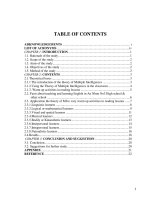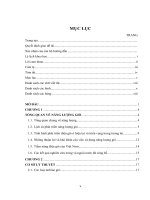Slide tiếng Anh thuyết trình về artificial intelligence (trí thông minh nhân tạo)
Bạn đang xem bản rút gọn của tài liệu. Xem và tải ngay bản đầy đủ của tài liệu tại đây (9.27 MB, 33 trang )
HANOI UNIVERSITY OF
SCIENCE AND TECHNOLOGY
Technical Writing
and Presentation
Class:
Lecturer:
Artificial Intelligence
Student:
INTRODUCTI
ON
0
5
EVOLUTION
OF AI
0
2
TYPES OF AI
0
6
FUTURE OF
AI
0
3
SUBFIELDS
OF AI
0
7
PROS AND
CONS
0
4
APPLICATION
OF AI
0
8
CONCLUSIO
N
0
1
INTRODUC
TION
0
What is
Artificial
Intelligence?
AI (Artificial Intelligence) is a machine’s ability to perform cognitive
functions as humans do, such as perceiving, learning, reasoning, and
solving problems.
HISTORY
1956:
Dartmouth
Conference –
“AI” adopted
1974-1980:
AI Winter
1980s: New
Hopes
1997: IBM
Deep Blue
beat a world
chess
champion
02
TYPES
OF AI
Threes types of AI
AI
ANI
Artificial Narrow
Intelligence – Narrow
range of abilities
AGI
Artificial General
Intelligence – On par with
human capabilities
ASI
Artificial Super
Intelligence – More
capable than a human
Artificial Narrow Intelligence
Goal Oriented
Predefined
Parameters,
Constraints,
Contexts
Single Task
NLP;
Versi
Examples of
narrow AI
Siri by Apple, Alexa by Amazon,
Cortana by Microsoft and other virtual
assistants.
Image / facial recognition
software
Marketing content
recommendations
Self-driving cars
Artificial
General
• Similar to human intelligence.
Intelligence
•
Also known as strong AI or full
AI.
•
Has human-like consciousness
and cognitive abilities.
•
Yet to become a reality.
•
Can solve unfamiliar problems.
Artificial Superintelligence
An intellect that is much smarter than the
best human brains in practically every
field.
An ASI system would be able to surpass
all human capabilities; include decision
making, taking rational decisions, and
includes things like making better art and
building emotional relationships
03
SUBFIEL
DS OF AI
•
Artificial Intelligence is the concept of
creating smart intelligent machines.
•
Machine Learning is a subset of
artificial intelligence that helps you
build AI-driven applications.
•
Deep Learning is a subset of machine
learning that uses vast volumes of
data and complex algorithms to train
a model.
WHAT IS MACHINE LEARNING ?
Machine learning is a
discipline of computer science
that uses computer algorithms
and analytics to build
predictive models that can
solve business problems.
Types of Machine Learning
Machine
Learning
Processes
Machine Learning Applications
WHAT IS DEEP LEARNING?
A subset of machine learning that deals with algorithms inspired by
the structure and function of the human brain.
Deep learning algorithms can work with an enormous amount of both
structured and unstructured data.
Deep learning’s core concept lies in artificial neural networks, which
enable machines to make decisions.
Neural
Network
Difference between Machine
Learning and Deep Learning
Types of Deep Neural Networks
04
APPLICAT
ION OF
AI
Applications
E-Commerce
Lifestyle
Robotics
Education
Social Media
Marketing
05
EVOLUTI
ON OF AI
1950’s to 1990’s
Rising Period
195
0’s
196
0’s
Starting Period
197
0’s
Steady
Development
Period
198
199
0’s
Low Development
Period
0’s









